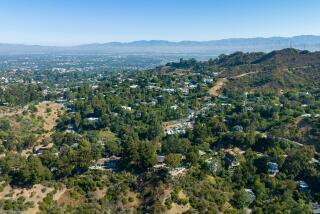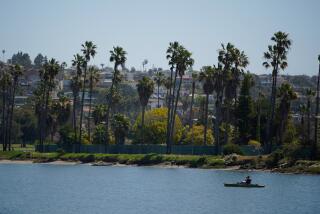Preservation of Kadota Fig Area Urged
- Share via
Simi Valley’s 488-acre Kadota Fig neighborhood, an island of farm animals, fruit trees and vegetable gardens in a sea of suburbia, should preserve its rural flavor, an advisory panel said in a report issued Friday.
The 11-member committee, formed last year to help the City Council decide the future of Kadota Fig, urged that horse trails be created and rustic design standards be imposed on new buildings and signs.
In its report, which will be reviewed Monday by the council, the panel recommended that curbs and gutters be prohibited along residential streets and that no commercial buildings in the area be allowed to exceed two stories. The committee’s vice chairman, Norman C. Rice, said he hopes the proposed rules will discourage developers from seeking to build condominiums and other urban projects that would alter the neighborhood’s character.
“This is the only place left in the entire Simi Valley where a person could buy a large lot with an older house on it, fix it up and have a nice place to raise their children in a rural atmosphere,” he said.
Rice, a general contractor, bought his three-fourths-acre Kadota Fig lot in 1977 and is almost finished building a house on it. He no longer keeps horses on the property, but his fruit trees are flourishing.
He treasures the quiet, rural environment.
“We can sit in my front yard,” Rice said, “and you don’t know you’re in the middle of 100,000 people.”
But some other property owners believe the Kadota Fig area, with its spacious lots, livestock and lack of sidewalks, is hopelessly out of place.
The community, in northeast Simi Valley, is bounded by heavily traveled arteries such as Alamo Street on the north, Cochran Street on the south, Stearns Street on the east and Tapo Canyon Road on the west. The Simi Valley Freeway cuts through the center of the area.
Julia Rose, who owns a three-acre horse ranch on Adam Road and attended several committee meetings, said she is dismayed that the panel did not recommend a zoning change that would allow condominiums on her land.
“I want it to go high-density,” said Rose, who has been breeding Morgan show horses on the ranch for three decades. “I could sell it and make money and retire. What people don’t understand is that if it does go to high-density zoning, they could get a lot more money for their land.”
Rose said her acreage, now worth about $600,000, could sell for more than $1 million if the zoning were changed. Kadota Fig is no longer a safe place for horse-riding, she said, because traffic is too heavy on the surrounding streets.
“Let us collect our money,” Rose said, “and go someplace more suitable.”
The tug of war between rural and urban advocates led city officials to poll Kadota Fig property owners in March, 1991. Most of the respondents living north of the freeway said the rustic area should remain as it is. But property owners south of the freeway were divided--some favored commercial zoning and others wanted a housing designation.
The advisory panel met between August, 1991, and this June to take a close look at development issues. Because of the survey results, the council ordered the panel to discuss zoning changes only in the section south of the freeway. Its other recommendations apply to the entire area.
A key area of dispute was the Cochran Street corridor between Tapo Canyon Road and Stearns Street.
“Most of the people on the committee felt they wanted it to stay low-density residential,” said Councilwoman Judy Mikels, who chaired the panel. “They didn’t want to see more commercial or apartments.”
The committee finally recommended that varying types of housing be permitted along that strip.
The panel also looked at traffic hazards and urged that “Horse Crossing” and “Caution--Horse Area” signs be posted. The group called for a 25-m.p.h. speed limit sign and other controls on Barnard Street, which is often used as a shortcut by drivers on their way to the Simi Valley Freeway.
City Council members will look at how the Kadota Fig proposals fit into Simi Valley’s overall development plans, and they may reject or alter some of the suggestions.
“This was a small committee that certainly was not even a majority of the neighborhood,” Mikels said.
The City Council’s decisions will probably not end the debate on whether to preserve the rustic island as the city develops around it.
“That’s a philosophical battle that will probably be fought for a long time,” Mikels said.
More to Read
Sign up for Essential California
The most important California stories and recommendations in your inbox every morning.
You may occasionally receive promotional content from the Los Angeles Times.












